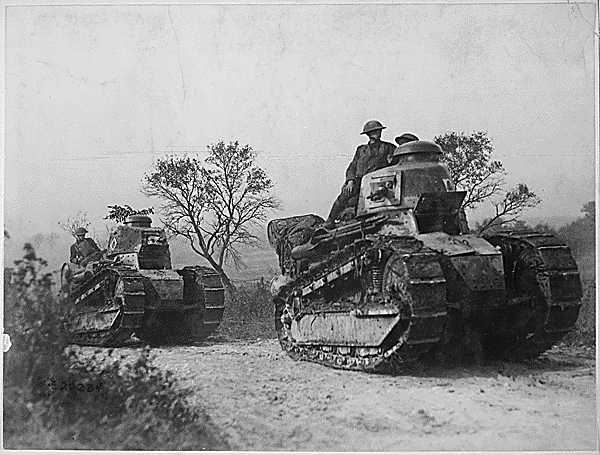Memorial Day Parade 1922: Runaway Tank Kills Veteran
Posted on Categories Discover Magazine

American troops on Renault FT tanks going forward to the battle line in the Forest of Argonne. France, September 26, 1918. Credit: U.S. National Archives
New York City Memorial Day celebrations have featured parades of military hardware almost since the earliest commemorations following the U.S. Civil War. Barely 15 years after that war’s end, Union Army veterans from New Jersey marched alongside a battery of rapid-fire Gatling guns in a New York City parade described as being “intended to eclipse all former demonstrations.” As World War I loomed just beyond the horizon in 1914, crowds cheered a “wicked looking battery of machine gun troop of New York Cavalry” and the “brave array of war equipment” on parade. But in 1922, one unfortunate military veteran was crushed to death between two light “whippet” tanks on parade after one of the armored vehicles’s engines started up for unknown reasons.
The sergeant of the Bronx National Guardsmen of the 27th Tank Company who died in that freak Memorial Day incident was named Julian Stahlschmidt. A board of inquiry later awarded him a posthumous medal of valor for trying to “stop a tank which had run amuck, threatening the lives of throngs who lined the sidewalks watching the parade.” It’s not clear from the initial New York Times story whether or not the tank had actually been threatening to crush crowds of spectators lining Riverside Drive along Manhattan’s Upper West Side. But it does seem that Stahlschmidt was trying to switch off the runaway tank’s motor when he slipped and fell between the armored vehicle and the tank lined up ahead of it.
Stahlschmidt, described as a veteran who served in the tank company of the 27th Division for three years, may have survived World War I only to have been killed by “friendly” war machines during his hometown Memorial Day parade. If he was indeed a tanker veteran from the Great War, he was probably among the first group of American soldiers to witness firsthand the rise of tanks as a battlefield technology.
Some mystery surrounds the identity of the tank that killed Stahlschmidt during the Memorial Day parade. The New York Times describes the tank in question as a “whippet,” which could potentially refer to a British tank called the Medium Mark A Whippet. The Whippets carried multiple machine guns and were designed to be lighter and faster tanks that could exploit breakthroughs in enemy lines.
But “whippet” was also used as a generic term referring to any number of different light tanks. That means the whippet tank that killed Stahlschmidt was not necessarily a British Medium Mark A Whippet.
It’s more likely that the runaway tank was either a French Renault F-17 or an American-made version called the M1917. The American tankers who fought in World War I typically made use of either British- or French-manufactured tanks, because none of the U.S.-produced tanks made it to Europe before the Armistice ended the war. The French supplied the American forces with the light tanks that could have been identified under the generic name “whippet,” whereas the British provided the Americans with heavy tanks in a different class than the British Medium Mark A Whippet.
The U.S. did begin mass-producing its own M1917 tank toward the end of the war under the project title “six-ton special tractor.” So it’s very possible that Stahlschmidt and his fellow members of the 27th Tank Company were operating these tanks during the Memorial Day parade.
Another unanswered question is why the runaway tank’s engine started unexpectedly. The incident occurred as six tanks of the 27th Division were on their way from the recently-ended main parade to a second march commemorating the unveiling of the Washington Heights Memorial. The tankers, including Stahlschmidt, had stopped their vehicles around 92nd Street and Amsterdam Ave to give their overheating engines a chance to cool down. The New York Times suggests that police later investigated the possibility that the motor was started by a “meddling bystander.”
When Stahlschmidt ended up crushed between his runaway tank and the second vehicle, his companions “quickly backed up the tractor and extricated the body,” according to the New York Times. They carried his body away from the curious crowds and took him to the St. Agnes Protestant Episcopal Church.
It appears that Stahlschmidt’s death was not forgotten by his fellow veterans. Eight years later, the August 1930 issue of the official state publication called The New York National Guardsman reported a memorial service that the 27th Tank Company held in Stahlschmidt’s honor. The tankers also unveiled a tablet commemorating how Stahlschmidt “gave his life in an attempt to stop a runaway tank headed for a crowd of spectators watching a memorial parade on Riverside Drive in 1922.”
“In doing this he showed the real spirit and training of a National Guardsman,” according to the New York National Guardsman. “He proved himself a real hero in the everyday walk of life in times of peace and on the streets of a crowded city.”